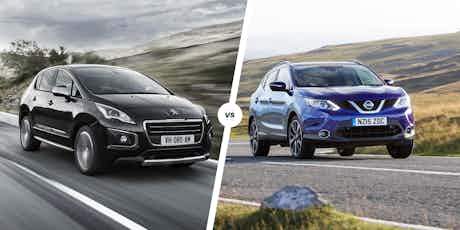Nissan Qashqai versus Peugeot 3008 – we crown the crossover king
July 15, 2014 by Lawrence Allan

Car manufacturers are always trying to create the next niche; ticking boxes that have never been ticked before, and in some cases that didn’t need to be ticked. Suzuki tried it a long time ago with the questionable (to be kind) X90 off-roader/two-seater coupe. BMW did it a few years back with the controversial (to be kind) X6 off-roader coupe. Neither was entirely successful (although the BMW sells well in the USA).
However, some niches were just meant to be. Crossovers (cars that combine the high driving position and rugged styling of an SUV with the easy-to-drive-and-park nature of a small hatchback) have taken Europe by storm. Nissan really got the ball rolling in 2007 with the British-built Qashqai. It was a definite sales success for the Japanese brand, selling more than a million units worldwide by 2011. The latest version hopes to capitalise on that success and continue to trump its rivals.
Soon after the Qashqai hit our streets, Peugeot tried to crash Nissan’s party with the 3008, which arrived in 2009. It wasn’t as much of a success story as the Qashqai, despite receiving favourable reviews at the time. Peugeot has also recently released an updated model, going head to head with the new Qashqai. So which should you buy if you’re hunting for a crossover?
Styling
This is clearly a subjective area, but it’s obvious Nissan has gone for a more upmarket look with the new Qashqai. The old model looked neat and functional, but not particularly classy. The stylish curves do a fair job of disguising that the new model is lower, longer and wider than before.
Bonnet creases and wrap-around headlamps with neat daytime running LEDs also help emphasise the Qashqai’s more dynamic and fashionable look that brings it right in-line with competitors. It doesn’t stand out in the class, and has a similar profile to the Hyundai IX35, but it doesn’t blend in too much either.
The Peugeot, on the other hand, falls behind in terms of styling. The original model looked like three totally different cars had been in a motorway pile-up; it was an incohesive mixture of dimensions and details, coming together to look, in profile, like a bad school art project. Fortunately, Peugeot saw sense and facelifted it this year, with a much more appealing front end. However, it still has the same bulbous rear overhang and oddly proportioned doors, which give it an unusual appearance. Round one to the Nissan.
Interior and practicality
In terms of ambience, it’s the Peugeot that has the more interesting interior. It’s designed to wrap around the driver like an aircraft cockpit, with large, easy-to-read dials and a dashboard angled towards your face. Critics praised French car’s material quality, saying it has come on leaps and bounds compared to Peugeots a decade ago. Some have said the layout of a few of the switches isn’t the most intuitive, however, and the satnav (standard on Allure and Active+ spec) can be confusing to operate.
The Nissan is more of a safe, if unexciting, design. But it certainly isn’t unattractive, and feels every bit as well-built and upmarket as the Peugeot. It also has good cabin storage space and some thoughtful design features.
Both cars have high and widely adjustable driving positions, allowing good views all-round, and there’s space in the back of both cars for three adults to sit in comfort. The boots are both good sizes, but the Qashqai beats the 3008 when the seats are up (430 litres versus 354), and the Peugeot wins when the seats are folded flat (1,604 vs 1,585 litres). The Peugeot also has a split tailgate, which will come in handy for unloading big objects.
Driving
The Qashqai has always been praised for feeling like a regular family hatchback to drive, despite its height. In the new version Nissan has sacrificed a little of that driving fun for a noticeable improvement in ride and refinement. Reviewers praise the new model’s ability to soak up bumps whilst still offering good handling balance. There is also much less road and wind noise than before.
Down-sizing is the order of the day in the Qashqai’s engine department: a new 1.2-litre turbocharged engine offers more torque than the old 1.6-litre unit, making it seem faster than the 0-62mph figure of 11.2 seconds suggests. The pick of the range is the 1.5-litre dCI diesel, which offers strong performance and a remarkable combined fuel economy figure of 74.3mpg. The 1.6-litre diesel offers as much performance as a traditional 2.0-litre, but drinks a bit more fuel.
The Peugeot, you might expect, shouldn’t be able to hold a candle to the Nissan because the 3008’s chassis and powerplants are older. Indeed the diesels (the ones to go for) can’t quite compete in terms of fuel economy or CO2 figures compared to the Qashqai. But both the 1.6-litre and 2.0-litre HDI engines are punchy, willing and perfectly adequate for motorway driving, and the larger of the two offers a decent turn of pace if required.
The 3008 also still handles well, with testers commenting on good body control and plenty of grip. The refinement isn’t as polished as the Qashqai’s, however, because of a fidgety low-speed ride. It also can’t compete with the Nissan in terms of all-round visibility, especially when you try to look over your shoulder out of the rear window. Luckily the parking sensors (standard on Active models and above) go some way to addressing that.
Value for money and running costs
There’s no doubt that the 3008 is the cheaper option. Starting at £15,995, it undercuts the base model Qashqai by £2,000. Once you’re into a mid-spec diesel model, the price difference remains the same. However, luxuries such as Bluetooth and cruise control, which are standard on even the basic Qashqai, are expensive options in the 3008. But mid-spec models level out on equipment, and the 3008 always ends up cheaper.
However, once you factor in things like the Qashqai’s much better fuel economy and lower CO2 emissions, the Nissan starts to make sense over the Peugeot. It also stands to retain more value over three years, thanks to being a new design. Its better refinement, comfort and styling help it towards the overall victory here.
If you are looking for a practical, no-nonsense family crossover, the 3008 is still a good solid choice. However, the new Qashqai matches – and beats it – in most areas, and is a nicer experience all round.
For more details about each model, read our full Nissan Qashqai review and Peugeot 3008 review sections, which have more photos, stats and details about each car.
















